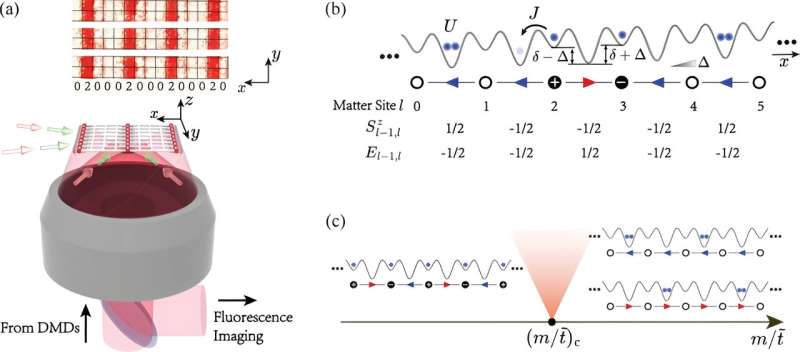This article has been reviewed according to Science X's editorial process and policies. Editors have highlighted the following attributes while ensuring the content's credibility:
fact-checked
peer-reviewed publication
proofread
Exploring the relationship between thermalization dynamics and quantum criticality in lattice gauge theories

Researchers from the University of Science and Technology of China(USTC) of the Chinese Academy of Sciences (CAS) have developed an ultra-cold atom quantum simulator to study the relationship between the non-equilibrium thermalization process and quantum criticality in lattice gauge field theories. The research was led by Pan Jianwei and Yuan Zhensheng, in collaboration with Zhai Hui from Tsinghua University and Yao Zhiyuan from Lanzhou University.
Their findings reveal that multi-body systems possessing gauge symmetry tend to thermalize to an equilibrium state more easily when situated in a quantum phase transition critical region. The results were published in Physical Review Letters.
Gauge theory and statistical mechanics are two foundational theories of physics. From the Maxwell's equations of classical electromagnetism to quantum electrodynamics and the Standard Model, which describe the interactions of fundamental particles, all adhere to specific gauge symmetries. On the other hand, statistical mechanics connects the microscopic states of large ensembles of particles (such as atoms and molecules) to their macroscopic statistical behaviors, based on the principle of maximum entropy proposed by Boltzmann and others. It elucidates, for instance, how the energy distribution of microscopic particles affects macroscopic quantities like pressure, volume, or temperature.
So, does a quantum many-body system described by gauge theory thermalize to a thermodynamic equilibrium when it's far from equilibrium? Answering this question would advance our understanding of gauge theory, statistical mechanics, and their interrelation. While theoretical physicists have proposed various models to analyze this issue, it remains experimentally challenging to construct a physical system that is both described by gauge theory and that can be artificially manipulated and observed during its thermalization process.
The emergence of ultracold atomic quantum simulators has provided an ideal experimental platform for studying gauge theories and statistical physics concurrently. In 2020, a research team from USTC developed an ultracold atomic optical lattice quantum simulator with 71 lattice points. This marked the first experimental simulation of the quantum phase transition process in the U(1) lattice gauge theory, specifically the Schwinger Model.
In 2022, the team simulated the thermalization dynamics of transitioning from a non-equilibrium to an equilibrium state in lattice gauge field theories. For the first time experimentally, they verified the "loss" of initial state information due to quantum many-body thermalization under gauge symmetry constraints.
Collaborators on this project, Zhai Hui and Yao Zhiyuan, have pointed out through theoretical research that there exists a correlation between quantum thermalization and quantum phase transitions in such lattice gauge models. Starting from the antiferromagnetic Neel state, they predicted that the system can achieve full thermalization only in the vicinity of the quantum phase transition point.
Observing the relationship between quantum thermalization and quantum phase transitions in lattice gauge theories poses new challenges to previous experimental capabilities: the challenge lies in how to control and detect many-body quantum states in situ with single lattice point precision and distinguishable atomic numbers.
On the foundation of their ultracold atomic quantum simulator, the team has combined techniques including quantum gas microscopy, spin-dependent superlattices, and programmable optical potentials. This amalgamation has paved the way for the development of atomic operations and detection techniques with single-site precision and distinguishable particle numbers.
Leveraging these advancements, the researchers were able to prepare and probe multi-atomic quantum states with any atomic configuration. Moreover, they tracked the dynamical evolution of many-body quantum states under the constraints of gauge symmetry.
In their study, the team experimentally prepared initial states with specific atomic configurations. They utilized the method of adiabatic evolution to investigate the quantum phase transition process under gauge symmetry constraints. For the first time in experimental conditions, they accurately pinpointed the phase transition point through finite-size scaling theory.
In addition, they explored the annealing dynamics of the same initial configuration when far from equilibrium. Their work unveiled a pattern wherein many-body systems with gauge symmetry, when near the quantum phase transition critical point, tend to thermally stabilize into an equilibrium state.
The journal Physics highlighted their achievements in an article titled "Watching a Quantum System Thermalize."
More information: Han-Yi Wang et al, Interrelated Thermalization and Quantum Criticality in a Lattice Gauge Simulator, Physical Review Letters (2023). DOI: 10.1103/PhysRevLett.131.050401
Charles Day, Watching a Quantum System Thermalize, Physics (2023). DOI: 10.1103/Physics.16.s115
Journal information: Physical Review Letters
Provided by University of Science and Technology of China





















